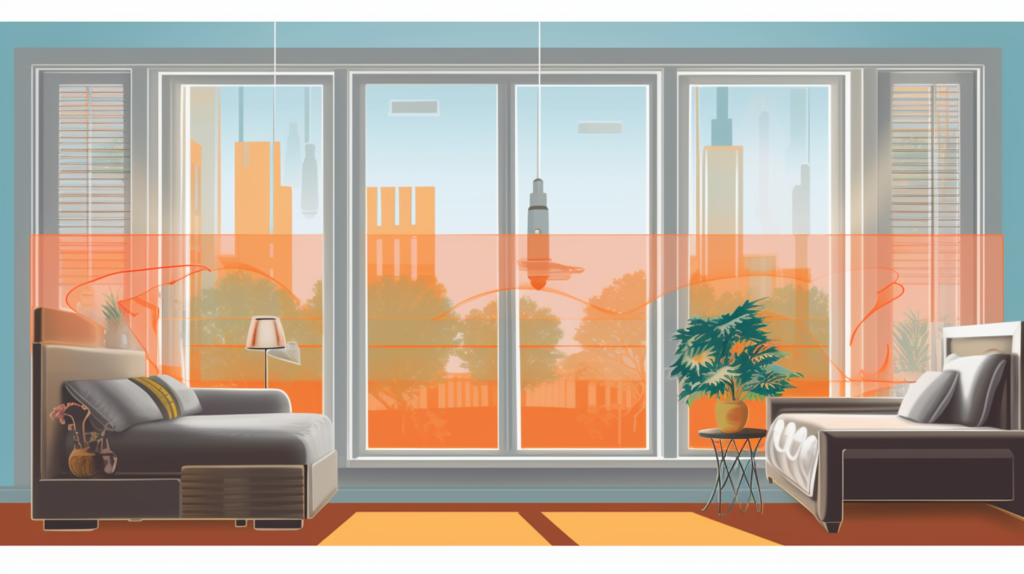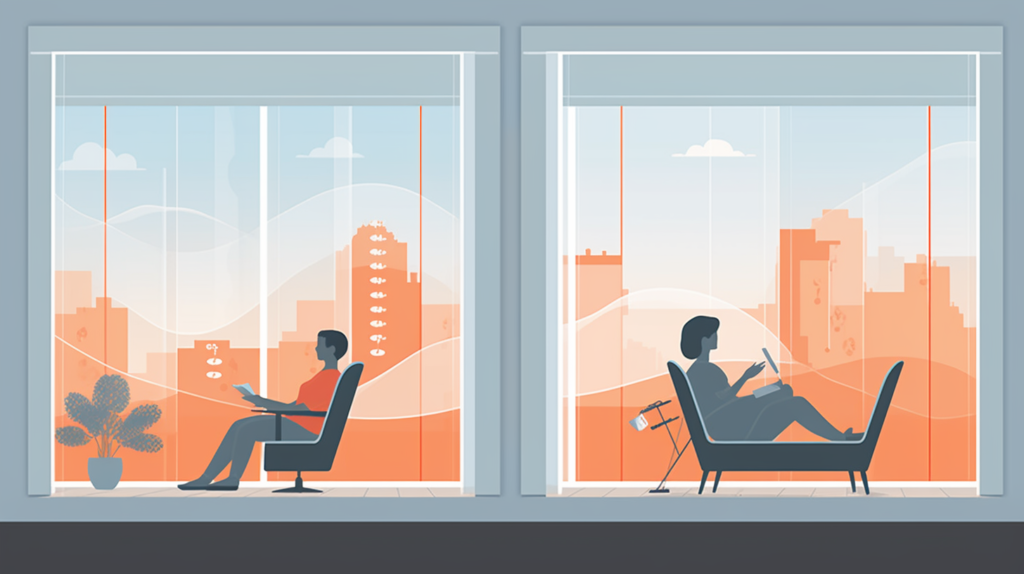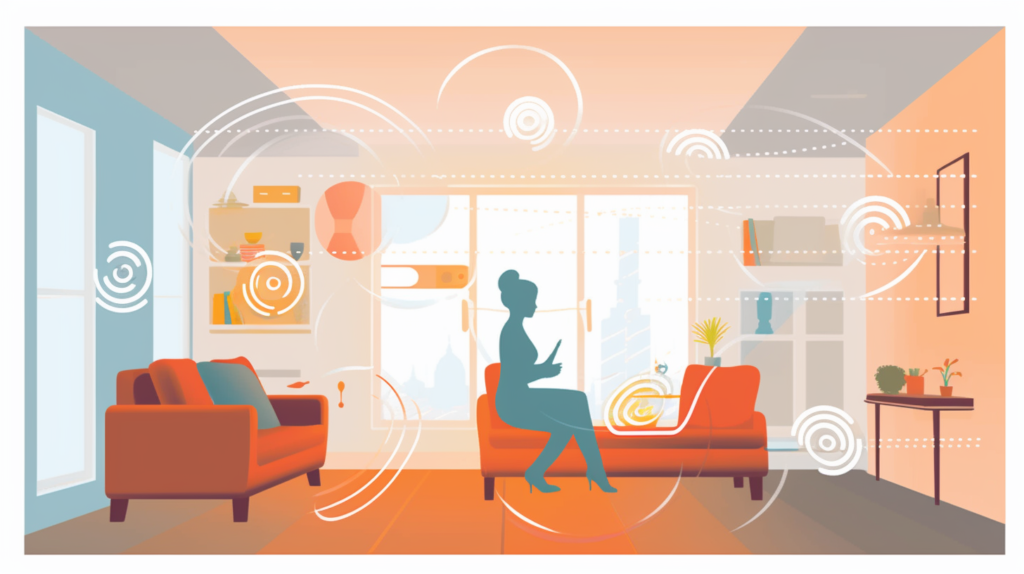Noisy neighbors blasting music. Sirens wailing down busy streets. The clamor of urban life can make your home feel more like Grand Central Station than a peaceful sanctuary.
But soundproof windows offer an oasis of noise reduction to restore tranquility.
With the double-pane, soundproof windows can decrease exterior noise by over 50-70% inside your home.
They block unwanted sounds so you can relax, sleep, or work undisturbed despite the commotion outside.
Let’s dive in to understand how soundproof windows achieve such impressive noise blocking and why they’re a smart upgrade.
How Do Soundproof Windows Block Noise?

The impressive noise reduction capability of soundproof windows stems from their specialized multi-layer construction and components.
Most feature double or triple glazed window panes with air gaps deliberately sealed between each pane. This layering creates several thin, trapped air chambers within the window assembly.
The separated air space acts as an insulating barrier that obstructs sound wave transmission.
As exterior noise impacts the outer glass pane, much of the initial sound energy is reflected instead of passing through.
The remaining sound that enters the air gap is effectively dissipated as it crosses the space through scattering and absorption.
The inner pane then reflects additional sound waves rather than transmitting them into the interior. This significantly dampens the noise through the multiple obstructions.
In addition to the noise buffering air gaps, the window panes themselves contribute to noise blocking.
Standard glass at least 3-4mm thick reflects some short wavelength sound while allowing longer waves to pass through.
By using two or more panes, this further improves the sound reflection.
Laminated glass incorporates a sound dampening plastic interlayer that absorbs noise energy and dampens vibrations that could transfer sound.
The composition of window pane glass can also be optimized for sound insulation, such as using double-density or acoustic laminated glass.
The air chambers work to block sound in a similar way that double or triple pane glass provides thermal insulation by trapping air. But the spacing and seals are specially designed to attenuate sound waves.
In addition to the noise buffering air gaps, soundproof windows incorporate interior laminated glass layers.
Laminated glass is constructed by permanently bonding two or more sheets of glass with a transparent sound dampening plastic interlayer sandwiched between them.
The viscoelastic polymer interlayer dampens vibrations and resonance that could transmit noise. This further absorbs and attenuates sound that reaches the inner layers.
Finally, soundproof windows are designed to seal tightly within their window frames to eliminate air gaps around the perimeter.
High quality weatherstripping and advanced frame materials block sound leakage that could compromise the acoustic isolation.
Minimizing any openings with an impermeable noise barrier is imperative for the windows to achieve maximum sound transmission loss.
The combination of strategically layered glass panes, multi-chambered air gaps, sound-absorbing laminated glass, noise optimized glass composition, and expertly sealed frames enables soundproof windows to effectively block disruptive levels of exterior noise through multiple integrated noise reduction mechanisms.
How Effective Are Soundproof Windows?

With their sophisticated layered construction and noise blocking components, today’s soundproof windows provide substantially more noise reduction than conventional windows.
They can decrease moderately loud to very loud exterior noises down to comfortable, unobtrusive interior sound levels.
Soundproof windows effectively attenuate noises from traffic and transportation, construction equipment, power tools, noisy neighbors, home appliances, urban bustle, nightlife crowds, and more.
Even high decibel noises only faintly register indoors thanks to the acoustic isolation provided. This allows maintaining serene, peaceful interior spaces unaffected by exterior commotion and racket.
Soundproof windows alleviate noise that could disrupt activities like reading, working, conversing, listening to media, practicing music, or pursuing hobbies.
Their noise screening abilities enable resting, relaxation, meditation, and sleeping completely undisturbed even during noisy daytime hours.
Bedrooms especially benefit from a sanctuary-like cocoon of serenity that remains blissfully quiet regardless of external clatter and chatter.
By preventing sleep interruption from outside noise, soundproof windows provide the health benefits of unfragmented sleep critical for energy, cognitive function, productivity and overall well-being.
Studies show traffic noise alone elevates stress hormones and blood pressure, while effective acoustic insulation helps facilitate restorative sleep.
With their considerable noise reduction capabilities, today’s soundproof windows truly deliver on their promise of peaceful, private interiors unaffected by noise intrusions.
They exceed other inadequate options like basic storm windows or minimally sound absorbing curtains that cannot match the all-encompassing acoustic isolation.
For once and for all blocking external noise nuisances from disrupting home life, activities, and health, specialized soundproof windows are an highly effective solution.
What Do The Sound Transmission Class (STC) Ratings For Soundproofing Windows Mean?

Soundproof windows are rated based on specialized laboratory testing to determine their Sound Transmission Class (STC).
This measures the window’s capability to reduce exterior noise as sound energy attempts to pass through the window assembly into interior spaces.
The STC rating provides a single number representing the window’s noise reduction performance for comparison purposes.
Testing is conducted by acoustic specialists according to ASTM E90 standards and methods.
First, loud standardized pink noise spanning a wide range of sound frequencies is generated using specialized loudspeakers aimed at the test window.
Pink noise contains an equal balance of all audible frequencies, critical for rating broad spectrum sound blocking across pitches.
A microphone outside the test window assembly measures the originating exterior noise level.
Then, highly sensitive microphones inside the window measure the resulting interior noise level simultaneously.
The difference in decibel measurements between the exterior noise at the loudspeaker and interior noise indicates how much sound was blocked.
These laboratory test results across the frequency range are then analyzed and converted into the final STC rating for that window configuration.
Typical soundproof windows suitable for most common residential settings have STC ratings ranging from 25 to 45. As a reference, normal speech averages around 60 decibels.
An STC 25 window would decrease this speech noise to an indoor level of 35 decibels. STC 45 would reduce loud speech to barely detectable levels indoors.
For especially challenging noise environments like directly adjacent to freeways, train tracks, entertainment venues, or airports, STC values of 40-45+ are ideal to sufficiently mute exterior noise down to unintrusive levels.
When selecting soundproof windows, choose products with STC ratings that match the intense exterior noise levels needing to be addressed.
Do Soundproof Windows Actually Reduce Noise In Real-World Use?

While STC ratings are useful for comparing the potential acoustic performance of soundproof windows, the lab test results alone do not guarantee real world noise reduction performance inside an actual home.
The true effectiveness inside dwellings depends on meticulous installation and maintaining complete airtight seals around the window assembly.
Even windows with STC values of 40+ can underperform expectations if overlooked gaps in sealing allow noise leakage.
Essential steps for maximal functionality include high quality weatherstripping around perimeters to seal against sound infiltration through the smallest openings.
Curtains or blinds also help muffle noise leakage around edges when closed. Any voids in weather seals, gaps between window sashes, or uneven fit within the frame can compromise the acoustic isolation and must be avoided.
Gaps as small as 1-3mm can significantly degrade noise reduction. Professional installation is recommended.
Also, windows must be sized and installed precisely to match the existing window openings without leaving cavities or cracks that could transmit noise. With careful workmanship and attention to detail during installation to prevent sound bridging, advanced soundproof windows can excel at real world noise blocking.
The substantial reduction in perceptible interior noise compared to conventional windows or mediocre acoustic products can be remarkable.
Those who have upgraded report exterior commotion becoming practically inaudible inside their homes.
While an investment, the noise reduction rewards in everyday living quality for both home and apartment residents can be tremendous.
To achieve maximum real world benefit, have soundproof windows installed methodically by experienced professionals.
Are Soundproof Windows Effective For Blocking Traffic Noise?

One of the most prevalent and disruptive external noise problems in urban areas is ceaseless traffic noise from adjacent busy roads, highways, rail lines, trams, or airports.
The continual din generated by high volumes of passenger vehicles, trucks, and trains passing by easily penetrates conventional building materials like walls and standard windows.
This subjects homes and apartments to invasive transportation noise pollution indoors.
Bedrooms, living spaces, and offices facing high traffic roads or transit corridors often suffer severely from disrupted sleep, hindered concentration, and constant irritation as the traffic roar continues day and night.
Soundproof windows are the ideal solution to eliminate such pervasive transportation noise problems and create peaceful habitable interiors.
By blocking the intruding noise, they return serenity and calm even in dwellings located steps from constant traffic.
The windows achieve this through the combination of carefully spaced glass panes, inner sound-absorptive laminate, and perfectly sealed frames that prevent loud traffic noises from penetrating indoors.
Where traditional windows fail, soundproof windows with adequate STC ratings succeed in allowing residents to live comfortably unaffected by the bustling transportation corridors around them.
Those facing chronic sleep disruptions or productivity loss from traffic noise outside can finally sleep soundly and work unbothered again after installing effective noise blocking windows.
By successfully addressing excessive traffic noise issues, soundproof windows restore tranquility and privacy from noisy urban settings.
What Other Benefits Do Soundproof Windows Provide?

In addition to substantially reducing noise pollution, upgraded soundproof windows offer a number of supplementary benefits that enhance homes.
The same multi-pane insulating glass that blocks exterior noise also provides thermal insulation that increases heating and cooling energy efficiency.
By preventing heat transfer, soundproof windows can help lower energy bills and electricity usage year-round while maintaining interior temperatures.
Valuable natural light still enters through the transparent glass while UV rays are often blocked to prevent fading of interior furnishings.
For security, soundproof windows are harder to break through when locked compared to single pane windows, keeping inhabitants safer.
Privacy is also increased as conversations stay contained within rooms rather than transmitting outside through open windows.
For apartment dwellers, upgraded windows prevent sound leakage between units, reducing noise complaints and neighbor disputes.
Aesthetically, soundproof windows are available with appealing tinted, frosted, patterned, or textured glass to match any decor.
Bamboo shades or curtains can be incorporated into some models for adjustable light control. Whether renting or owning, high performance soundproof windows increase property value for resale as noise reduction becomes a coveted luxury amenity.
For developed areas where external noise constantly encroaches on home life, soundproof windows deliver extensive benefits beyond just minimizing noise disruptions.
They are an investment that can significantly elevate comfort, privacy, safety, efficiency, and overall residential satisfaction.
Conclusion
In conclusion, soundproof windows are an exceptional solution for reducing external noise intrusion into living spaces.
Their advanced multi-layered construction blocks noise through the use of insulated glass panels, laminated glass, and expert airtight sealing.
Soundproof windows effectively attenuate noise from traffic, neighbors, construction, and other community clamor to create peaceful interiors ideal for relaxation and sleep.
While professional installation is recommended, properly implemented soundproof windows can make a tremendous difference in real-world noise reduction inside homes and apartments.
Beyond just minimizing noise disruptions, they also improve privacy, energy efficiency, security, aesthetics and resale value.
For those seeking refuge from the hubbub of urban life, noise blocking soundproof windows can restore tranquility and improve quality of life.
